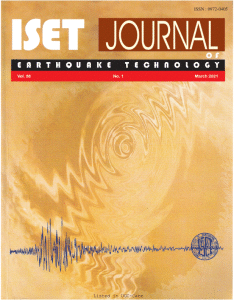Home > Issues & Journals
A RESPONSE SPECTRUM-BASED MODAL COMBINATION RULE FOR PEAK SEISMIC RESPONSE USING PEAK FACTORS
Abhilash S. Ghumadwar and Vinay K. Gupta
Paper No.: 587
|
Vol.: 61
|
No.: 3
|
September, 2024
|
pp. 71–90

Abstract
Most response spectrum-based modal combination rules used to estimate linear peak responses of multi-degree-of-freedom systems to specified seismic hazard assume that the nonstationary peak factors relating the root-mean-square responses to the largest response peaks are identical for the modal and overall system responses. This study accounts for the role of nonstationary peak factors by modifying an existing modal combination rule (a) which has been formulated for the peak value of an overall system response that can be expressed as a linear combination of the floor displacements in a lumped mass, classically damped, multistoried structure, and (b) which uses the hazard-consistent response spectrum ordinates to account for modal cross-correlation. To this end, available models for the normalized peak factors of the relative displacement and relative velocity responses of a base-excited single-degree-of-freedom system (where normalization is with respect to the peak factor for ground acceleration) are used. Also, the normalized peak factor for overall system response is modelled in terms of the normalized peak factors for modal responses. The proposed rule is illustrated in the case of floor displacement and story shear responses with the help of five buildings and six earthquake excitations in comparison with the existing modal combination rules.
Keywords: Modal Combination Rule; Ground Acceleration Peak Factor; Relative Displacement Peak Factor; Relative Velocity Peak Factor; Overall Response Peak Factor; Normalized Peak Factor Models
©2025. ISET. All Rights Reserved.